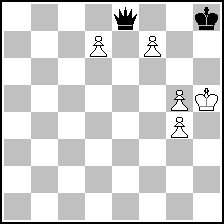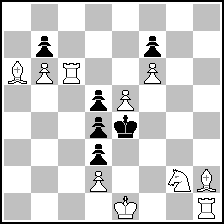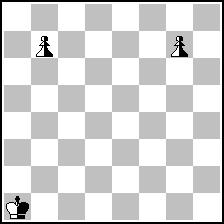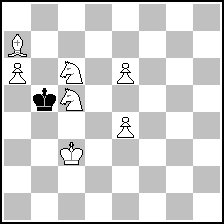
Website founded by
Milan Velimirović
in 2006
22:50 UTC


| |
MatPlus.Net  Forum Forum  General General  Delayed Vacation Circe? Delayed Vacation Circe? |
| |
|
|
|
|
You can only view this page!
| | | (1) Posted by Kevin Begley [Wednesday, Feb 2, 2022 04:58] | Delayed Vacation Circe?
This post has been revised, in my attempt at clarity.
I have often thought this condition (which I will hereby propose) should exist -- needs to exist! -- but, I have delayed a call for it for some time, in hopes I could provide a problem to accompany my petition for the addition of this condition.
Since I never get around to composing a single decent example, I thought it best to announce the condition, if only to motivate me to make something.
Thus, if the name is not taken, and this is indeed a new fairy condition, I propose the following condition:
Delayed Vacation Circe (aka DVC, but NOT Delayed PWC, nor DPWC, nor Delayed Exchange Circe, nor Vacation Circe).
The rules are fairly self-explanatory (I hope).
Let's call Vacation Circe = PWC (aka Exchange Circe, aka Platzwechsel Circe, aka Blue Horse Shoe), except that pawns on the first rank default to allow a single-step move or a capture move.
(note: I don't know if that distinction will be useful to anyone, but it's useful to describe what I am proposing).
In Delayed Vacation Circe, units are reborn not immediately following capture, but immediately following the move which follows a capture (like Parrain Circe is actually Delayed Equipollent Circe, DVC is like a Delayed form of PWC, except that Delayed PWC seems a dreadful mistake -- as defaulting to dummy pawns in the delayed form of the condition would severely hamper the condition's potential).
Rules for DVC:
After a capture, the captured unit is reborn onto the square next vacated on the move following the capture.
Since castling moves vacate two squares simultaneously, the player on the move has a choice of rebirth squares.
En Passant moves also vacate two squares simultaneously, and theoretically the player on the move would have a choice of two rebirthing squares, except that en passant is never preceded by a capturing move -- so, that choice is purely theoretical.
Pawns reborn on their 8th rank are immediately promoted (as chosen by the player on the move).
REVISED: Pawns reborn on their 1st rank may capture or move one square, by default (as in Parrain Circe, Equipollent Circe, etc).
I do not like the PWC default, but I had tried to maintain consistency with PWC to create a Delayed PWC (I was inclined to propose changing those defaults, so all fairy conditions would enjoy that consistency), but the PWC rule is deemed to be a disaster for the delayed condition (inhibiting pawns with the whole board ahead of them would constitute an unusual cruelty, as it would occur with greater frequency than in PWC).
As noted, Parrain Circe is equivalent to Delayed Equipollent Circe.
ContraParrain is a Delayed + Mirrored Equipollent Circe (which is almost like Delayed PWC, but not quite).
This is not (by default) completely equivalent to Delayed PWC, but it's my best attempt to round out the field.
NOTE: the player on the move does not have a choice of PWC rebirth or Delayed PWC rebirth (though that is a remarkable idea, which a reader likely derived from my unclarity).
ASIDE: I consider that brilliant accident to offer a very interesting prospects to combine one immediate circe condition with a delayed circe condition (normally two circe conditions combined will result in The Xerox Paradox, but it might be interesting indeed if a player had the option to accept an immediate rebirth or delay that rebirth to the opponent. There is much to consider here.).
DVC Example: after 1. e4 d5 2. exd5,
Black may play 2...Ke8-d7 [+bPe8] (e8 is vacated, so the black pawn is reborn there, and NOT as a dummy).
Or, black may play 2...e5 [+bPe7] which would allow 3. dxe6 (but, as mentioned, there's no opportunity here for a rebirth choice -- as rebirths only occur on the moves following a capture).
I went back and forth on two points in the rules -- specifically:
1) pawns on the first rank (whereas I am a firm believer that pawns on their first rank should enjoy the default of a single-square move plus captures, I also tried to maintain consistency with the default in PWC (aka exchange circe, aka platzwechsel circe).
At first, I was inclined to cave to the consistency with PWC argument.
After some thought, I realized this default would be far too hampering in the delayed condition, so I had to make revisions.
Dummies can not be the default in this condition (dummy pawns in PWC are an exception, but in the delayed form, games -- and proofgames -- would all suffer an invasion of dummies -- "the walls are closing in!").
Thus, it's best to call this Delayed Vacation Circe or DVC (it's like Delayed PWC, except that, by default, pawns are reborn free and uninhibited).
Unless people in this forum can convince me otherwise -- that's not going to be easy on the 1st rank pawns issue! -- this is what I propose.
2) is there a rebirth choice on castling moves?
I generally favor rebirth options (again, unless people in this forum can convince me otherwise -- and I'm more easily persuadable on this issue).
I do understand there's a good case to make for maintaining a certainty in rebirth squares (I myself generally prefer conditions where a player's only options are what unit to move, where to move it, and what to promote -- let rebirths be determined entirely by moves).
I went back and forth on these special cases, and ultimately, I leave it for the problem community to decide the matter.
But, this is my carefully considered proposal.
I think castling is a special case where a choice is logically warranted (a unique move with two simultaneous square vacations deserves to confer to the player a choice of rebirths).
If you have a preference, please voice it (I may be more persuadable than anyone might imagine, and I appreciate alternative perspectives).
If programmers have a preference, I'm inclined to weigh their suggestions with the greatest consideration.
If somebody wants to help me out, and provide some examples, I'd welcome and appreciate any help illustrating the condition.
Clearly, this also opens a window for Delayed Vacation Anticirce (the rules for which I leave to others -- same goes for Parrain Anticirce).
| | | (2) Posted by James Malcom [Wednesday, Feb 2, 2022 07:34] |
If I understand the rules correctly, here is a small demonstration.
s#1
 (= 5+2 ) (= 5+2 )
1. dxe8=B Kg7[+bQh8]#
This can even make captures illegal at times. The bishop cannot be taken as it would still be in check from the reborn bishop.
#1
 (= 3+1 ) (= 3+1 )
1. g8=B#
I believe giving a choice castling is the better option as it allows for more logic and strategy. It is bound to produce interesting results.
Here is a quick show of the possiiblites.
#2
 (= 10+6 ) (= 10+6 )
1. Nh4 zugzwang
1... bxa6 2. 0-0[+wBh1]#
1... bxc6 2. 0-0[+wRe1]#
| | | (3) Posted by Kevin Begley [Wednesday, Feb 2, 2022 08:15] |
Thank you, James.
In the s#1, what if 1...Kh7 [+bQh8] ?
I must be missing something.
In the #1, taking the bishop is legal -- there is no rebirth until after.
Maybe I wasn't clear. My apologies. This is not combined with PWC, it's only a delayed PWC.
In the #1, 1.g8=B+ Kxg8 and that bishop will be reborn (either on h5 or f6) according to white's next move (King or Bishop, respectively).
Your #2 certainly applies the condition correctly, but it looks incorrect to my eyes.
White can move the King, or the Rook, and rebirth (as well) -- castling there appears only to offer a dual.
| | | (4) Posted by Ulrich Voigt [Wednesday, Feb 2, 2022 08:19] |
I think your #1 example is wrong: Why can't Black answer 1... Kxg8? The bishop isn't reborn on h7.
| | | (5) Posted by Kevin Begley [Wednesday, Feb 2, 2022 08:24] |
Agreed Ulrich, the #1 is incorrect (as is the s#1 -- 1...Kh7 [+bQh8] -- and castling in the #2 only offers dual mating moves).
I suspect I wasn't clear in stating this is not PWC + delayed PWC.
Captured units are only reborn immediately following the move following capture (after which point, checks are evaluated).
James may be combining both conditions, somehow where the player to move may chose rebirths.
That's a very interesting interpretation, I must say (making my unclarity seem a blessing)!
(note: generally, combining two circe rebirth conditions leads to the Xerox Paradox).
I also want to revise my decision about pawns on the 1st rank.
I was dead wrong. Pawns on the first MUST default to a 1-square move -- otherwise, the delayed condition is just dead as a game (you end up with dummies invading the first rank, and a pawn at the start of the board should not be so inhibited).
The default for pawns on the first must be to allow movement (as in Parrain Circe, Equipollent Circe, etc).
I tried to be consistent with PWC, but no way!
This consistency would be disastrous for the condition, which would inevitably produce only dummies on the first rank.
That prospect calls to mind the Surf Punks hit, "(Watch Out For) The Dummies" -- I can't describe it any better than that.
Case closed. No dummies by default.
| | | (6) Posted by Joost de Heer [Wednesday, Feb 2, 2022 15:25] |
Castling usually is considered a king-move, so the rebirth square should always be the king-square.
| | | (7) Posted by Kevin Begley [Wednesday, Feb 2, 2022 16:19] |
Joost has spoken.
I trust Joost on castling matters.
So, there it is.
I'm sold.
Not even joking -- that, right there, is enough to convince me.
Castling moves which follow capture should always result in rebirth onto the square vacated by the King (never the Rook).
So, there it is. Those are the rules. All settled. Final Answer.
Unless there's some special case I have failed to consider, I believe this condition is now well defined.
We just need some examples, which I will try to produce in the next few days.
| | | (8) Posted by Joost de Heer [Wednesday, Feb 2, 2022 21:59] |
 (= 1+3+2N ) (= 1+3+2N )
h#1.5 DVC (b) a1->c6
| | | (9) Posted by Kevin Begley [Thursday, Feb 3, 2022 00:00] |
a) diagram
1.a8=nR! Rh8 2. gxh8=nB#! (a picturesque mate)
b) bKa1->c6
1.g8=nQ! Qb8 2. axb8=nS#!
Nice neutral AUW, and a wonderful first demonstration of the condition!
This makes a strong case for this condition (if I do say so myself).
Thanks, Joost.
ps: [edited]
I suspect you might be able to eliminate both black pawns with a slight shift of nPa7 (somewhere, and keep wK on its diagonal to avoid 1. a8=nQ in the first phase), while still retaining all benefits of the long diagonal in the first phase.
Wouldn't the following work?
 (= 1+1+2N ) (= 1+1+2N )
h#1.5 DVC (b) bKa1->a7
If my guess is correct, you may have a 4-man neutral AUW, in only 1.5 moves, achieved in very little time.
That certainly makes me curious what more might be possible in this condition (in, say, two moves, or more). :)
Edit: Oh, duh! Now, I get it. No, saving pawns fails, because the neutral Knight moves away in phase 2.
This is the real reason you need the pawns (not to shield bKa1 from self-checks of the a8=nR, but to prevent both 2.nSa7 [+nQb8] and 2.nSd7 [+nQb8] (either of which would nullify mate in the second phase).
Nor can you reduce the count of black pawns by, by making the Knight promotion in the opposite corner.
One bP on c7 (intending bKa1->b6 in phase two) would close the diagonal which prevents nQ promotion in the first phase.
One bP on b6 would force the bK to c7, which invites nPb8xc8=nR/nQ# (rather than the intended nPb8xa8=nS#).
Shifting wK to the other diagonal (at a7), would similarly force the bK to c7 (which fails as above).
So, it seems you have everything well under control.
| | | (10) Posted by Kevin Begley [Thursday, Feb 3, 2022 07:39] |
err.
| | | (11) Posted by seetharaman kalyan [Thursday, Feb 3, 2022 09:35] |
@Joost. Excellent AUW! Superb use of new condition.
| | | (12) Posted by Joost de Heer [Thursday, Feb 3, 2022 11:44] |
Nah, it's a trivial modification of an old AUW I published years ago.
 (= 1+2+2N ) (= 1+2+2N )
h#2 Ghost chess (b) a2->g6
Only improvement compared to this is that the captures are reciprocal. In the Ghost chess composition, h7 is neutral only to avoid the B/Q dual in a.
> Nor can you reduce the count of black pawns by, by making the Knight promotion in the opposite corner.
Actually, you can, nQc8 is an illegal selfcheck. For some reason I only tried Kb6 and not Kc7.
 (= 1+2+2N ) (= 1+2+2N )
h#1.5 DVC (b) a1->c7
| | | (13) Posted by Joost de Heer [Thursday, Feb 3, 2022 17:41] |
Does this work?
 (= 1+1+2N ) (= 1+1+2N )
ser-=2 DVC (b) wKf6->f7
g7,h7=neutral Berolina pawn
a) 1. gh8=nR 2. hh8=nS=
b) 1. gh8=nQ 2. hh8=nB=
| | | (14) Posted by Joost de Heer [Thursday, Feb 3, 2022 17:53] |
Never mind, the orthodox h#2 also works.
| | | (15) Posted by Kevin Begley [Thursday, Feb 3, 2022 19:51] |
@Joost,
Yes, that does save a pawn.
For some reason, I thought that was cooked by =nQ/R, then nRc8 followed by bxc8=nQ/R (neglecting that the second move is an illegal self-check).
So, wait... how exactly does b) bKa1->c7 fail (if you put the bP on b6, and keep the wK on h2)?
ps: I think this would get you close to a N/Q twin, without any bP's (but it requires a zero-position and twinning on stipulation).
Also, less harmonious than your version.
 (= 1+1+2N ) (= 1+1+2N )
h==1.5 DVC
I think it's the only h=1.5, but it happens to also be a h==1.5 (unless I've missed something).
| | | (16) Posted by Kevin Begley [Thursday, Feb 3, 2022 20:04] |
What if:
 (= 0+0+3N ) (= 0+0+3N )
h=1.5? DVC
No. The above now ends in either =nR or =nS -- this required wK (or a neutral King?) on the h-file, to force the S promotion.
I may need a refresher on neutral Kings (as many attempts to produce a h# twin here caused only confusion). :)
| | | (17) Posted by Kevin Begley [Friday, Feb 4, 2022 02:05] |
 (= 7+1 ) (= 7+1 )
#2 DVC
1.Sa4!
...Kxa4 2.Kb2 [+wSc3]#
...Kxa6 2.Sc5 [+wPa4]#
...Kxc6 2.Bb8 [+wSa7]#
| |
No more posts |
MatPlus.Net  Forum Forum  General General  Delayed Vacation Circe? Delayed Vacation Circe? |
|
|
|
 ISC 2024
ISC 2024 Forum
Forum  General
General  Delayed Vacation Circe?
Delayed Vacation Circe? 


